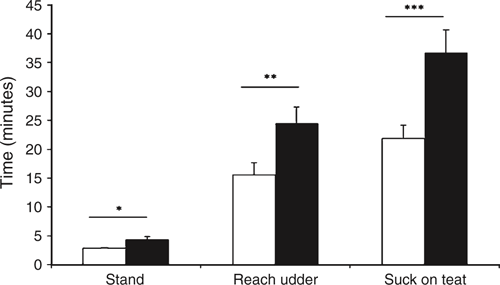Effect of sow confinement and non-confinement during parturition on piglet viability
P. C. Condous A C , K. J. Plush B , A. J. Tilbrook B and W. H. E. J. van Wettere AA The University of Adelaide, Roseworthy, SA 5371.
B South Australian Research and Development Institute, Roseworthy, SA 5371.
C Corresponding author. Email: patricia.condous@adelaide.edu.au
Animal Production Science 55(12) 1513-1513 https://doi.org/10.1071/ANv55n12Ab026
Published: 11 November 2015
Sows housed in farrowing crates have previously been shown to have prolonged farrowing durations compared to sows housed in confinement-free systems (Oliviero et al. 2008). An increase in farrowing duration can increase the degree of hypoxia in the piglet and consequently decrease piglet viability at birth (Herpin et al. 1996). This study tested the hypothesis that measures of piglet viability would be improved when sows farrowed in confinement-free compared to confinement housing systems.
One hundred and fifty-four piglets were born from gilts that were housed in a swing-sided pen with the sides of the pen open (OPEN; n = 69 piglets) or with the sides closed (CLOSED; n = 85 piglets) for the entire experimental period. At the birth of each piglet, a mixed blood sample (sow and piglet blood) was collected from the umbilical cord and plasma glucose was measured. The times taken from birth to stand, reaching the udder of the sow and sucking on a teat were recorded for each piglet. Two hours after birth, rectal temperature and body weight were recorded for each piglet. Data were analysed using a general linear model with farrowing treatment and replicate as fixed effects and total litter size as a covariate (IBM SPSS, Version 21.0; USA). Data were considered significant at P < 0.05.
The number of total and live born piglets was not different (P > 0.05) between treatments, and averaged 12.1 ± 0.7 and 11.4 ± 0.7 piglets per sow, respectively. Piglets born from sows housed in OPEN pens took less time to stand, reach the udder and suck on a teat compared to piglets from sows housed in CLOSED pens (Fig. 1). There was no difference between treatments in umbilical cord glucose concentration (OPEN, 3.9 ± 0.1 vs CLOSED, 3.7 ± 0.1 mmol/L; P = 0.82), rectal temperature at 2 hours after birth (OPEN, 37.0 ± 0.2 vs CLOSED, 37.4 ± 0.2°C; P = 0.85) or weight at 2 hours after birth (OPEN, 1.4 ± 0.03 vs CLOSED, 1.4 ± 0.04 kg; P = 0.16). These results indicate that allowing sows to farrow in a confinement-free environment can improve certain aspects of piglet viability, which could lead to potential improvements in piglet performance in these systems.

|
References
Herpin P, Dividich JL, Hulin JC, Fillaut M, Marco FD, Bertin R (1996) Journal of Animal Science 74, 2067–2075.Oliviero C, Heinonen M, Valros A, Halli O, Peltoneimi O (2008) Animal Reproduction Science 105, 365–377.
| Crossref | GoogleScholarGoogle Scholar |
Supported by Pork CRC Limited Australia.


